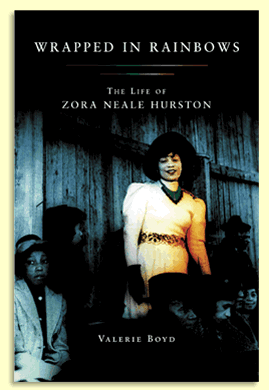 |
 |
 |
 |
 |
 |
Review: Wrapped in Rainbows by Valerie Boyd
By Emily Bernard
From the January/February issue of Black Issues Book Review
A misidentified photograph says it all. During the 1980s, as interest in Zora Neale Hurston’s life and work began to gather speed, a widely-circulated photograph of a young black woman wearing a wide-brimmed hat and an enormous smile put a face to our fascination. But the face wasn’t Hurston’s. Even after the photographer himself, famed anthropologist Alan Lomax, notified the Library of Congress of this error in 1993, the image continued to circulate as an authentic Hurston likeness. It still does.
This is only one of the mistakes surrounding Zora Neale Hurston that Valerie Boyd corrects in her wonderful and engaging biography, Wrapped in Rainbows: The Life of Zora Neale Hurston. Taking on the task of interpreting Hurston’s life is, in itself, a brave choice. It is possible that no other African-American women writer has been both source and object of such public anxieties, myths, fantasies, and fears. In her biography, Boyd manages to present us with a rich portrait of this icon, one that both honors the life that was lived as well as the myths that it produced.
Valerie Boyd accomplishes this in a gorgeous prose style that beautifully resonates with Hurston’s own. Her writing perfectly reflects the inventive linguistic playfulness of her subject, as well as the poetic gravity of the life she lived. Describing Hurston’s approach to Harlem Renaissance gatekeeper, Alain Locke, Boyd writes: “Zora seemed to take Locke’s suggestions with a box of salt.” Of Zora’s disdain for bitterness, Boyd reasons: “It was, Zora knew, like drinking poison and expecting the other person—the resented one—to die.” Introducing the hardest episode in Hurston’s life, in which she was wrongly accused of child molestation, Boyd prepares her readers: “The charges came out of nowhere, like a puff of poisonous gas. Or like a sudden, savage thunderstorm on a cloudless day.” The biography is rife with moments like these, in which Boyd achieves something rare and remarkable, which is to produce a biography that is once sound in its scholarship and luminous in its language. That she has accomplished this with such complex and difficult subject is simply awe-inspiring.
Boyd’s own talents do not interfere with her delivery of Zora Neale Hurston to readers in her own, majestic, inimitable words. Describing an automobile mishap to a friend, Hurston wrote: “Somehow, all the back of my skirt got torn away, so that my little panties were panting right out there in public.” Of a failed research jaunt, Hurston wrote: “I went back to New York with my heart beneath my knees and my knees in some lonesome valley.” About white opportunists who routinely “borrowed” from black culture: “It makes me sick to see how these cheap white folks are grabbing our stuff and ruining it. My one consolation being that they never do it right and so there is still a chance for us.” Throughout Wrapped in Rainbows, Hurston’s words can wound like razors and soothe like the gentlest touch. Zora Neale Hurston’s linguistic powers are nearly magical, and are artfully represented and complemented by Boyd’s own creative skills.
Hurston is not simply the unappreciated daughter of the Harlem Renaissance here, as she has often been depicted by scholars and biographers. The Zora Neale Hurston in Wrapped in Rainbows is a committed, passionate anthropologist, whose creative ambitions make those of several other Harlem Renaissance writers and artists seem puny by comparison. Hurston loved Harlem, but was beckoned throughout her life also by the Bahamas, Haiti, and of course, the American South. Through multiple heartaches, betrayals by friends and colleagues, and episodes of poor health, Hurston remained steadfast in her commitment to recording the lives of the “Negro farthest down.” Her curiosity was limitless, and she was fearless, too. Threats at knifepoint by women jealous of her popularity and ease with men, deadly hoodoo rituals, and the relentless assault of white racism—none of it could keep Hurston from her work, which she always turned to for inspiration, and for meaning.
Popular wisdom has it that Hurston died penniless, in poor health, and ignored by the world. Hurston was poor and sick at the end of her life, but Boyd’s readers will not find these facts coated in a weepy lament. In fact, Wrapped in Rainbows is a sobering portrait of a woman determined to live by her writing in a society that had other, lesser plans for her. Truly crushing moments in Hurston’s professional life—like the episodes detailing the various ways Hurston was mishandled by the Rosenwald Fund and the Guggenheim Foundation—reveal the internecine nature of the racism that Hurston faced in a professional world that purported to believe in her. But what is salient about these episodes is how valiantly Hurston survived them. With a bigness of spirit and a firm sense of purpose, Hurston soldiered past those who seemed determined to see her fail. Hurston believed in her work, and until the end of her life, labored away on book and story ideas, facing down rejection letters with humor and calm. What’s finally tragic about Hurston’s life is how much it reflects our own negligence when it comes to our geniuses—at least while they are alive. The tragedy is not Hurston’s; the tragedy is our own.
Emily Bernard is the author of Remember Me to Harlem: The Letters of Langston Hughes and Carl Van Vechten.


|
|
|


